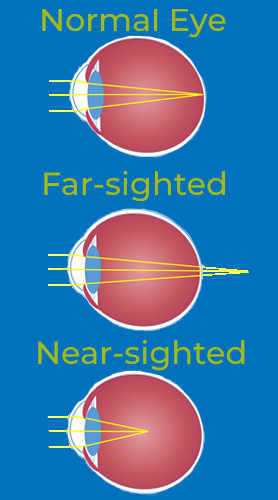
Eye Exams Madison
Routine eye exams are the best way to maintain your eye health and we’re here to help. Unfortunately, there are many diseases of the eye that don’t have any symptoms at early stages. Early detection is the best way to prevent vision loss.
Common Vision Disorders

Myopia (Nearsightedness)
If you can read without glasses, but things across the room are blurred, your eyes are nearsighted.
Our best vision is achieved when light focuses perfectly on our retina. The nearsighted eye is usually longer than a normal eye. Therefore, when light passes through the cornea and lens, it’s focal point is in front of the retina. This will make distant images appear blurred.
There are several refractive surgery solutions available to correct nearly all levels of nearsightedness.
Hyperopia (Farsightedness)
At low and moderate levels of hyperopia, people are able to see well both up close and far away. Gradually, the effects of hyperopia become more apparent and reading glasses are needed much sooner than for someone with myopia.
The farsighted eye is usually slightly shorter than a normal eye. This means that the light entering the eye focuses behind the retina. The natural lens inside the eye can help compensate for this, do a degree. It loses that ability gradually and people usually need reading glasses at age 35-40.
LASIK, refractive lens exchanges, and contact lenses are a few of the options available to correct farsightedness.
Presbyopia
In children and young adults, the lens inside the eye can easily change shape to focus on distant and near objects. With age, the lens loses its ability to focus adequately. To compensate, people usually find that holding reading material further away makes the image clearer.
Ultimately, aids such as reading glasses are typically needed by the mid-forties. Besides glasses, presbyopia can be dealt with in a number of ways. Options include monovision and multifocal contact lenses, monovision laser vision correction, and new presbyopia correcting implant lenses.

Dry Eyes
Feeling gritty? Burning? Scratchy? Light sensitive? Or maybe your vision fluctuates all day. These are all usual symptoms of dry eyes, a common condition when your own tears are unable to sufficiently lubricate the eyes.
It may be that you do not produce enough tears or you have poor quality tears. It might be that the tears you have are not being appropriately spread across your eye by your eyelids.
Some risks factors for dry eyes include:
- Being female
- Being elderly
- Underlying medical condition (Sjogren’s Syndrome, Thyroid Eye Disease, Rheumatoid Arthritis, etc.)
- Having an eyelid condition called “Blepharitis”
- Working on screens / computers for extended periods
- Reading for extended periods
- Working in dry or air conditioned environments
- Extended facial covering wear
There is a wide range of treatment options for dryness: medicated drops, ointments, and lubricants may be necessary.